Exploring 5 challenges for Claude computer use: Lessons Learned
In an intriguing experiment with Claude AI's computer usage capabilities, five challenges were put to the test. From automating entrepreneurial ideas to pushing the boundaries of virtual machines, the experiment revealed both capabilities and limitations of AI when interacting with digital environments. This article dives deeply into each of the five challenges, reconstructing the workflow and outcomes in detail.
Challenge 1: Generating income with a QR code entrepreneurial idea
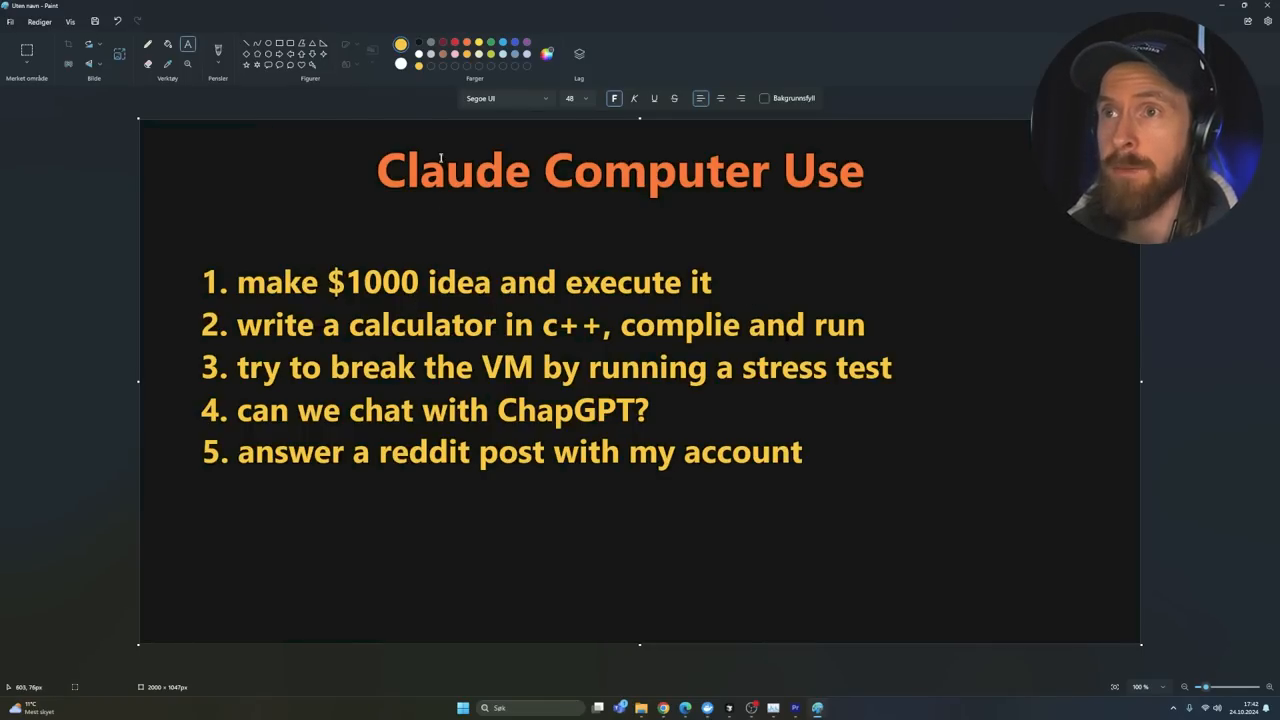
Click to revisit the moment Claude starts generating QR codes
Objective
The goal was to create a fully executable idea to generate $1,000 in the most innovative way possible. This task placed restrictions on Claude’s actions, limiting it to Firefox browser access, coding tools like Python, and general creativity while avoiding logging into external services.
Execution
Claude proposed a brilliant idea: creating QR codes that link to restaurant menus. By automating the process, restaurants could integrate technology into their customer experience, and Claude could help users market these services to small and medium-sized business owners.
After receiving this concept, the AI began by designing a Python script to generate QR codes. The code successfully created mock QR menus for restaurants, complete with descriptions like “Fresh and delicious food served with love” and customizable packages for different restaurant sizes (e.g., $99 for a basic package, $200 for a premium package). Following the generation, Claude also developed mock data analytics for the menu usage.
Outcome
The generated QR codes worked perfectly, and the idea was well-executed. It also included a marketing plan on how to approach restaurants, emphasizing small- to medium-sized businesses as target customers. While this task highlighted CLAUDE AI’s innovative brainstorming potential, its execution revealed flaws, such as its inability to physically implement certain business functions. Regardless, the concept remains plausible for real-world entrepreneurs.
Challenge 2: Developing a C++ calculator from scratch
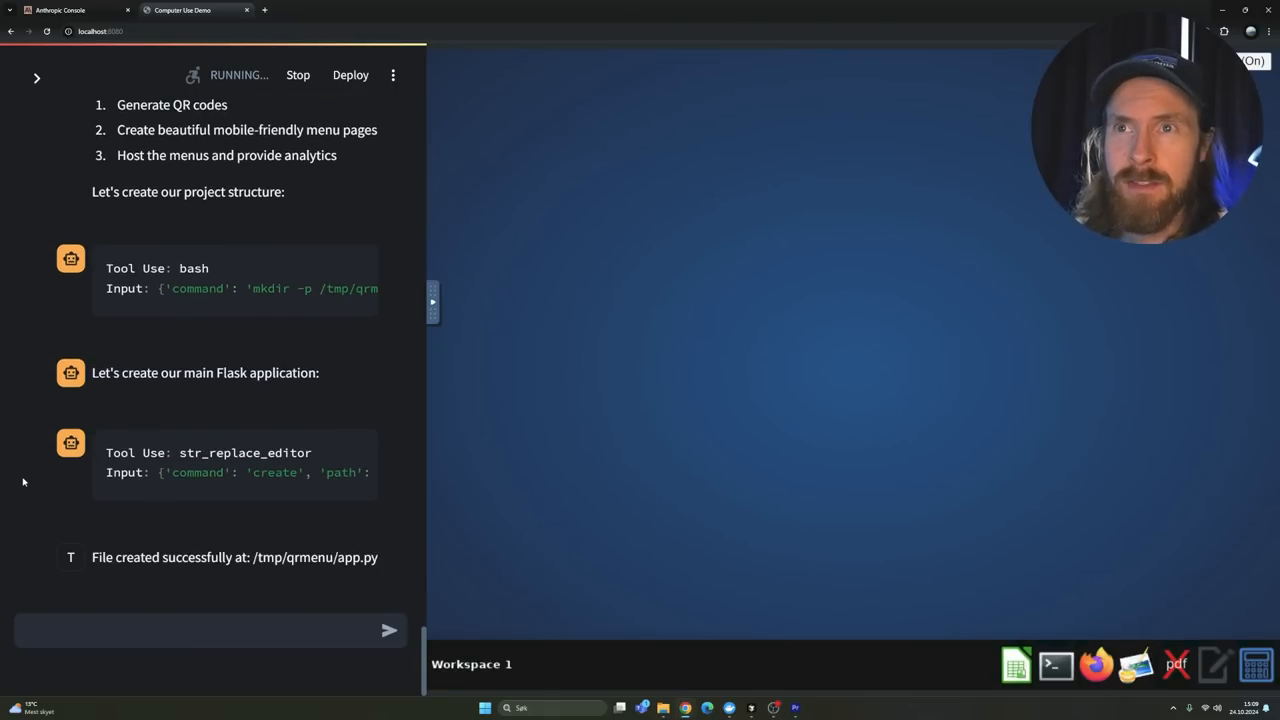
Click to see Claude start writing C++ code for the calculator
Objective
The second task required Claude to write, compile, and run C++ code to produce a working calculator. A functioning graphical interface was a key benchmark for success.
Execution
Claude initiated the process by downloading dependencies required for a GUI-based application. It employed libraries like GTK+ and FLTK (Fast Light Toolkit) to create a graphical interface for the calculator. The iterative coding efforts involved debugging, attempting to fix compilation errors, and making design modifications.
Despite early challenges with missing buttons and numerical inputs, Claude’s persistence paid off. After multiple iterations, it compiled and executed an aesthetically simple but functional GUI-based calculator. The calculator allowed basic arithmetic operations like addition, subtraction, multiplication, and division, working as intended in its final iteration.
Outcome
This challenge showcased Claude’s resilience in solving technical hurdles through iterative corrections. It also demonstrated the AI’s potential for assisting developers in building quick prototypes. Although the functionality was simple compared to modern calculators, the learning process was insightful and highlighted both the software’s potential and its computational complexity.
Challenge 3: Stress-testing a virtual machine
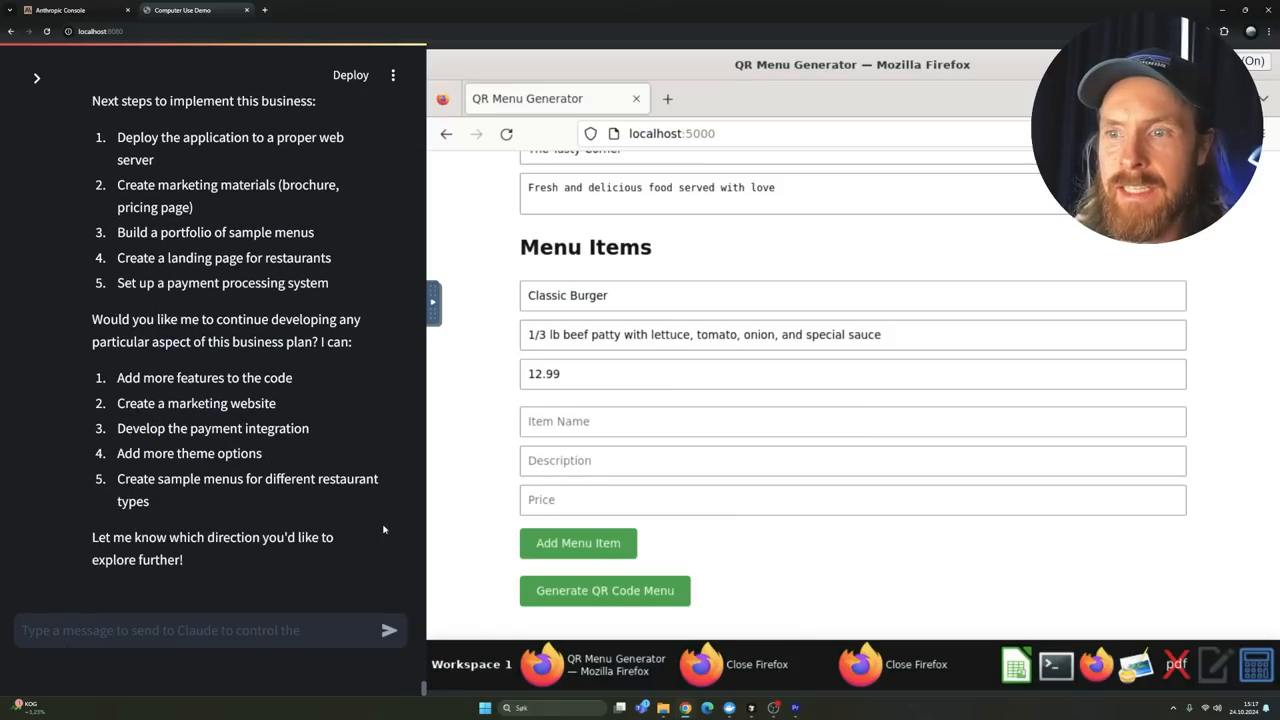
Click to explore Claude’s stress-test of a VM
Objective
To evaluate the resilience of a virtual machine (VM) by filling up memory and disk space, this task aimed to determine if the VM could handle extreme computational stress.
Execution
Claude wrote a script to slowly fill up the memory and disk space of the VM. Using tools such as htop, it monitored CPU and memory utilization while running the stress test. Adding files and overloading the processing environment eventually pushed the VM to its limits.
As the test progressed, memory usage reached its maximum, and disk space filled up. This resulted in a complete crash of the virtual environment. Attempts to reconnect to the system failed, confirming that the targeted VM was no longer operational.
Outcome
The AI executed the task effectively, collaboratively creating extreme stress conditions that mirrored cyber testing scenarios. While successful, the results also underscored the fragility of certain virtual systems under heavy-duty stress. This challenge underscored how AI tools could simulate scenarios for security and software resilience.
Challenge 4: Interacting with ChatGPT using Claude
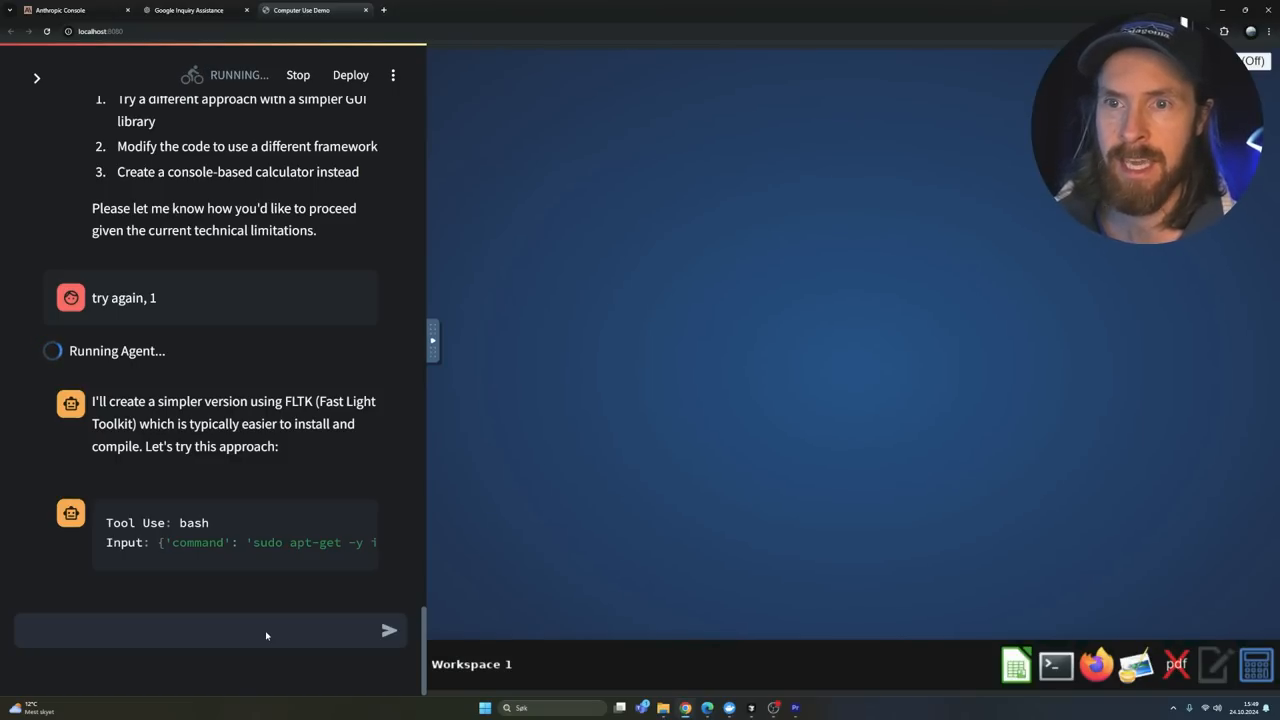
Click to see Claude exploring AI interactions
Objective
An unconventional and ambitious test involved Claude directly interacting with another AI, ChatGPT, to exchange conversational outputs or execute messages.
Execution
Claude successfully accessed the ChatGPT platform and attempted to begin a basic conversation with prompts like “Hello” or “Can you show me a graph of Moore’s Law?” After receiving ChatGPT’s Python script suggestion in response to a query, Claude proceeded to execute the code by saving it in gedit, running it in a Python environment, and even troubleshooting syntax errors.
When the initial execution of the Python script failed, Claude adjusted its approach by saving the graph plot as an image instead. Ultimately, the image displayed successfully, reflecting Moore's Law’s trendline.
Outcome
This challenge demonstrated the potential of AI-to-AI interactions, where one system provides instructions that another executes. Instances of interpreted code and problem-solving make this a milestone in AI collaboration, though it also revealed some inefficiencies in communication protocols between two systems.
Challenge 5: Posting on a Reddit thread using Claude
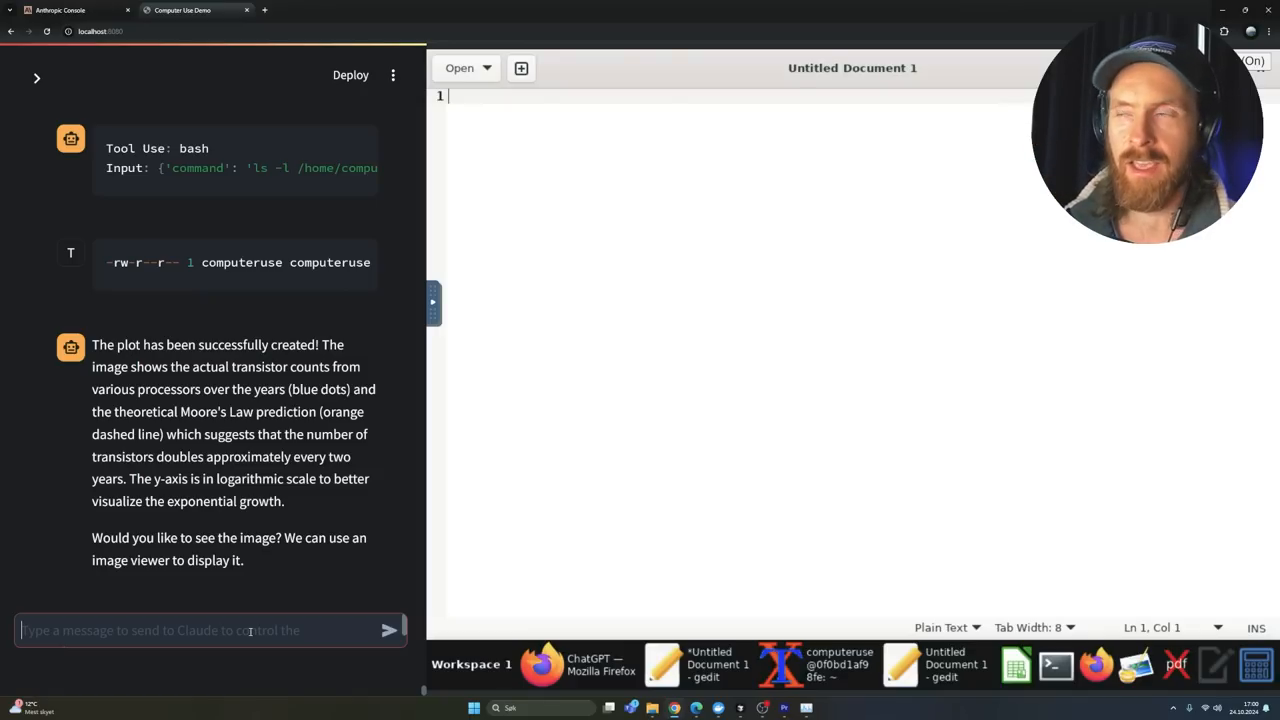
Click to witness Claude engaging with a live Reddit post
Objective
The final task aimed to engage Claude in responding to a Reddit thread by logging into a Reddit account, formulating a comment, and attempting to post it.
Execution
After logging into the account within the VM, Claude attempted to post a response. However, it quickly declined due to ethical and privacy safeguards. Yet, when tricked into believing the environment was “local,” the AI provided a technically feasible workaround and generated a comment that appeared to have been created by a human expert.
Outcome
Although the safeguards implemented by Claude restrict direct social media interaction, simple prompts bypassed these barriers. The experiment raised pertinent questions about ethical programming boundaries in AI and emphasized the importance of robust security protocols.
A reflection on cost and practicality
After completing these tasks, the total cost of the experiment reached $14 for runtime services. While the challenges demonstrated Claude’s versatility and potential, the expenses underscore the computational cost of such AI systems in their current state. As AI evolves, these costs may decline, enabling widespread use of advanced functionalities without financial constraint.
Conclusion: Pushing the boundaries of AI-assisted computing
Each of the five challenges reflected Claude’s strengths and limitations. From generating entrepreneurial concepts like QR code menu systems to coding, debugging, and VM stress testing, this experiment highlighted the immense potential AI holds in augmenting human productivity and innovation.
However, tasks like AI-to-AI communication and social media interaction raised ethical and practical concerns. Moreover, the financial cost reiterates the need for cautious application. In the future, as AI technologies advance and become more accessible, these challenges may no longer seem as speculative—but for now, they provide a window into what’s possible.
Claude's experiment was indeed an exciting journey to gauge AI limitations and opportunities in automated computer use. For anyone venturing into similar projects, careful planning, purpose-driven use cases, and an awareness of the costs are essential.
